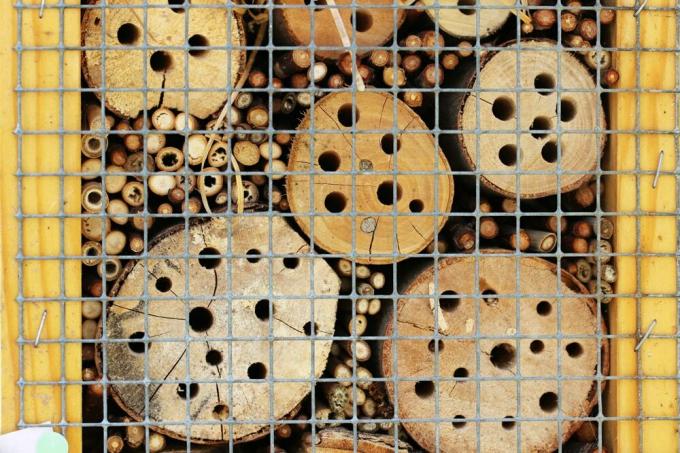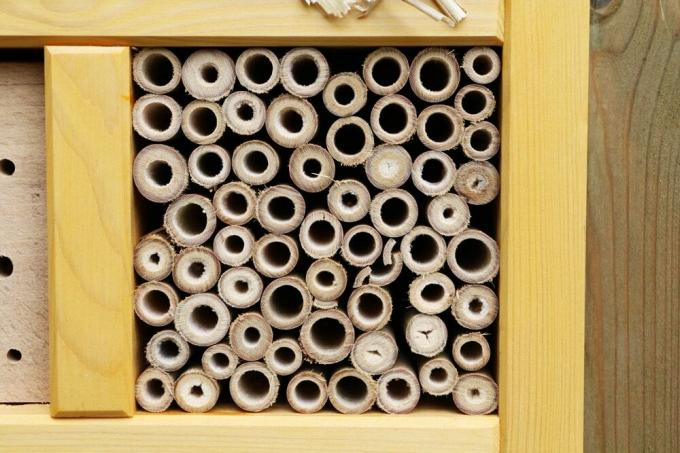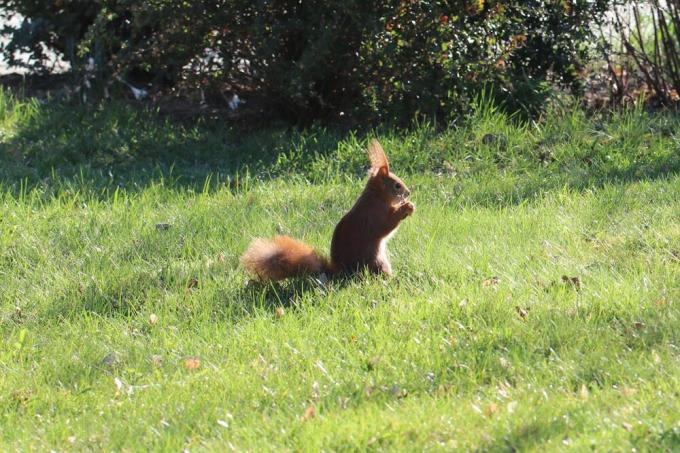

Table of contents
- The right time to set up the insect hotel
- Why is the right location so important?
- The right alignment
- Easily accessible food sources
- Install insect hotel as high as possible
- Protect insect hotel from birds
- In the furthest corner of the garden or rather next to the terrace?
- No change of location in winter!
- Can you put an insect hotel on the balcony?
At a time when such useful insects as wild bees, bumblebees, earwigs, lacewings and even butterflies are dying due to in the Pesticides used in agriculture and insufficient food sources are becoming fewer and fewer, setting up an insect hotel is all the more important more important. However, in order for the animals to accept this nesting and wintering aid, the location must be planned precisely. Insects feel most comfortable in a sunny spot in the middle of a fragrant sea of flowers.
The right time to set up the insect hotel
The best time to set up an insect hotel is between March and September, as the animals constantly colonize such a dwelling during the warm season. Wild bees, for example, swarm out in March and have their main flight time in April and May - here there is the highest chance that the insect hotel will be populated by the red mason bees, which are relatively easy to attract becomes. Most other beneficial insects - such as lacewings or earwigs - are only on the move from June or even July.
In principle, however, insects need shelter all year round: During the spring and summer months, eggs are laid here, es larvae hatch and develop. In addition, many insects (such as wild bees) like to spend the summer nights in the sheltered environment of a insect hotels. During the cold season, on the other hand, the box serves as a hibernation aid for both larvae and adult animals.
Why is the right location so important?

You will only attract numerous insects in a suitable location - if the location is not suitable, the insect hotel will remain empty and rot unused. The choice of location is so important mainly for these reasons:
- Insects need a lot of warmth, especially during their development period
- The insect hotel should not be permanently damp and clammy.
- Such conditions prevent the hatching and development of the offspring
- Insects prefer to be close to their food sources.
- They should also be protected from predators and other threats.
Tip:
An insect hotel must always be firmly anchored and must not be allowed to dangle freely from a branch.
The right alignment
Ideally, align the insect hotel to the south - here the insect shines from morning to evening Sun, it's bright, warm, sheltered from the wind and the rain doesn't get into the inside of the wooden box in. Under such conditions, eggs and larvae can develop optimally, so that the insects can expect plenty of offspring.
However, a north-west orientation is not suitable. Here, on the so-called weather side, the sun rarely comes out, it's drafty and when it's wet the rain gets into the house. A north-east orientation is just as uncomfortable. Most commercial insect hotels have weather protection in the form of a roof structure and / or rear wall, but this is not primarily intended to protect against permanent moisture sufficient.
Facts about alignment at a glance:
- Orientation to the south is optimal
- as much sun, warmth and protection from wind and rain as possible
- do not hang in a north-west or north-east direction
- Weather side is always too dark and too humid
Tip:
Standing water in the nest tubes can kill the eggs and larvae of many species. Therefore, it is best to place or hang the insect hotel tilted slightly forward. In this way, penetrating moisture drains away quickly.
Easily accessible food sources
But not only the direction determines the optimal location of an insect hotel, the proximity to the food sources is also relevant. So that bees, bumblebees and the like do not have to fly far, it is best to position the box in the immediate vicinity of flowering forage plants. In order to attract additional animals, you can use flowering plants in your garden, such as Cranesbill, gorse, prairie candle, lavender, thyme, zinnia, coneflower, lilac and others plant species.

The proximity to the vegetable and ornamental garden with its numerous perennials, shrubs and vegetable plants also provides food for those insects that feed on aphids, for example. Rose lovers benefit in a very special way from an insect hotel: the beneficial insects keep the aphids in the roses small. In combination with interplanted lavender - which butterflies, bees and bumblebees are happy about - nothing stands in the way of a successful colonization of the insect hotel.
Tip:
Usually it is enough to set up the house in the right place and wait a bit - in the warm season an insect hotel is quickly accepted. However, if you don't want to wait that long or prefer to settle certain beneficial insects, you can also buy lacewings and others in specialist shops. You then simply set them out directly at the insect hotel.
Install insect hotel as high as possible
Furthermore, the insect hotel should be installed as far away from the floor as possible. You should mount the box at least 50 centimeters high, but preferably at about head height. This not only prevents moisture from the ground from settling in the wooden box and the material faster rotten, the height prevents even small children as well as cats, dogs and other animals from curiously rummaging in the Nesting box. So that they feel comfortable, the insects should not be disturbed unnecessarily - also prevent them They so that dogs and children get stung by bees or wasps by angry hotel residents capture.
Tip:
An insect hotel can be placed very well on the trunk of a tree, for example inside an orchard. A meadow orchard, which is also maintained as a wild meadow with many flowering herbs, is an ideal location for an insect hotel.
Protect insect hotel from birds
Of course, protection against the most important predators of insects should not be neglected, otherwise blackbirds, woodpeckers and various songbirds could be the insect hotel with a rich buffet confuse with. So that the hungry fowl cannot get to the tasty insects, it is best to stretch a wire mesh a few centimeters in front of the box. For this purpose, for example, close-meshed rabbit or rabbit wire very good. Insects can easily pass through the mesh, but the beaks of blackbirds and the like can then no longer reach the protective passages of the house.
Tip:
Experience has shown that a blue bird protection net is the best way to prevent birds from plundering the insect hotel. Most bird species recognize the color from afar and avoid it from the start.
In the furthest corner of the garden or rather next to the terrace?

It is entirely up to you whether you want to install the insect hotel right next to your terrace or in the furthest corner of the garden. The insects themselves are not bothered by the presence of humans as long as they can find enough food in the immediate vicinity. However, a placement near the house or the terrace has the advantage that hungry birds can be disturbed by humans and therefore leave the insects alone. Since even wild bees and wasps are very peaceful and usually don't sting, you don't need to be afraid here either. You should only be careful if you or a family member have an allergy to bee and/or wasp stings – in this case, you should rule out all eventualities and actually put the insect hotel in the back corner of the garden to ban.
No change of location in winter!
Once hung or set up, you should always leave the insect hotel in its place - even when it gets frosty in winter and there is a thick layer of snow outside. Do not bring the box with the wintering insects and their larvae into the house or any other warm place - this will only completely upset the biorhythm of the animals. If it's suddenly so warm, the animals swarm out, believing it's already spring, and die a miserable starvation. In the middle of winter they will not find any forage plants. Quite apart from that, many insect larvae need a cold period for their development.
Can you put an insect hotel on the balcony?
You can also attach a nesting aid for wild bees on the balcony, for example. In contrast to honey bees, wild bees do not form colonies but look after their brood alone. They are also extremely peaceful and avoid any confrontation. The animals are very useful for balcony gardeners, as they pollinate many flowering plants.
 garden editorial
garden editorial I write about everything that interests me in my garden.
Learn more about beneficial insects

What does hedgehog droppings look like? | Recognize hedgehog droppings
Hedgehogs are not only very cute, but also useful animals. a. devour the unpopular slugs in the garden. They feel particularly comfortable in natural gardens. Their legacies, which can even be hazardous to health, are less pleasant.

What does raccoon droppings look like? How to recognize him
Raccoons are purely outwardly, quite cute contemporaries. However, this does not hide the fact that these are wild animals that can cause great damage in the garden and on the house. This masked intruder can pose a danger to residents and pets.

Recognizing squirrel droppings: typical appearance with picture
Gardens provide an oasis for many wild animals to forage there. The animal visitors leave clearly visible traces in the form of droppings. If you take a closer look at the pieces of excrement, you can see which animal was the cause based on certain clues.

Recognizing fox droppings: 5 characteristics with a picture of the fox droppings
If animal droppings are found in the garden, it is annoying in any case. However, there can also be a danger with fox droppings in particular. But how can fox droppings be recognized and what should be considered when removing it?

drive away wild bees | What to do against wild bees in the garden?
If you want to drive away and get rid of wild bees, you should use natural and gentle means. Because the insects are useful in the garden and generally important for the environment. In addition, they are rarely threatening. We reveal how the fight works.

List: these ant species exist in Germany - ants
Ants can be found everywhere, whether in the forest, on a roadside, in the garden or even on the terrace and in the house if there is something interesting for the animals. But not all ants are the same, there are over 13,000 species of ants worldwide, 200 of them in Europe alone.
